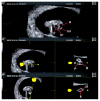Transvaginal three-dimensional sonographic assessment of the embryonic brain: a pilot study
- PMID: 26528064
- PMCID: PMC4576774
- DOI: 10.15386/cjmed-437
Transvaginal three-dimensional sonographic assessment of the embryonic brain: a pilot study
Abstract
Aims: A very good knowledge of human embryology is mandatory not only for the correct sonographic assessment of the developing brain, but also for better understanding the origins of congenital anomalies involving the central nervous system. 3D transvaginal sonography may be an effective technique for imaging the developing brain. The aims of this explorative study are to demonstrate the feasibility of imaging the embryonic brain between 7 and 10 weeks of gestation for clinical studies by using a 3D high-frequency vaginal ultrasound transducer and to provide a reference for the morphology of the brain in the embryonic period.
Materials and methods: Four embryos of 9 mm, 17 mm, 23 mm and 31 mm crown-rump length respectively were assessed in vivo by transvaginal sonography. We gave a special attention to the embryonic brain. All patients were examined with a Voluson E10, BT 15 ultrasound scanner (GE Healthcare, Zipf, Austria), using a high-frequency 6-12 MHz/ 256-element 3D/4D transvaginal transducer. Three-dimensional sonography was performed routinely as the patients were scanned. The multiplanar display was used after selecting the best volume. The Omni view® software was used for digitally slicing the selected volumes.
Results: We describe the morphological details of the developing brains of four embryos ranging from 7 to 10 gestational weeks. In the human embryo 9 mm CRL the hypoechogenic cavities of the three primary vesicles (prosencephalon, mesencephalon, rhombencephalon) could be observed on a sagittal section. In the human embryo 17 mm CRL the prosencephalon was divided into the median diencephalon and two telencephalic vesicles, which were partially separated by the falx cerebri. In the human embryo 23 mm CRL the cerebral hemispheres developed and they were completely separated by the falx cerebri. The choroid plexus was evident inside the lateral ventricles and the fourth ventricle. In the human embryo 31 mm CRL the ventral thalamus was evident, and the ganglionic eminence, as the precursor of the basal ganglia, was well seen on the floor of the cerebral hemispheres.
Conclusions: Studies of embryology are still needed for a complete understanding of the developing brain. 3D sonography using a high-frequency vaginal ultrasound transducer is feasible for imaging the embryonic brain with an acceptable quality for clinical studies.
Keywords: 3D transvaginal ultrasound; developing brain; human embryo.
Figures





Similar articles
-
Ganglionic eminence within the early developing brain visualized by 3D transvaginal ultrasound.Med Ultrason. 2015 Sep;17(3):289-94. doi: 10.11152/mu.2013.2066.173.rbb. Med Ultrason. 2015. PMID: 26343075
-
Ultrasound visualization of the central nervous system during embryonic and fetal periods: Neurosonoembryology utilizing multiple three-dimensional transvaginal ultrasound technology.Prenat Diagn. 2023 Jun;43(7):901-909. doi: 10.1002/pd.6362. Epub 2023 May 24. Prenat Diagn. 2023. PMID: 37150864
-
[Three-dimensional sonoembryology--myth or reality].Akush Ginekol (Sofiia). 2010;49(6):26-30. Akush Ginekol (Sofiia). 2010. PMID: 21427872 Bulgarian.
-
[Embryo-fetal ultrasonographic diagnosis in the early pregnancy using transvaginal echography].Minerva Ginecol. 1997 Mar;49(3):95-108. Minerva Ginecol. 1997. PMID: 9173346 Review. Italian.
-
Normal sonographic development of the central nervous system from the second trimester onwards using 2D, 3D and transvaginal sonography.Prenat Diagn. 2009 Apr;29(4):326-39. doi: 10.1002/pd.2146. Prenat Diagn. 2009. PMID: 19003788 Review.
References
-
- Blaas HG, Eik-Nes SH. Sonoembryology and early prenatal diagnosis of neural anomalies. Prenat Diagn. 2009;29:312–325. - PubMed
-
- Blaas HG. Detection of structural abnormalities in the first trimester using ultrasound. Best Pract Res Clin Obstet Gynaecol. 2014;28:341–353. - PubMed
-
- Timor-Tritsch IE, Peisner DB, Raju S. Sonoembryology: an organ-oriented approach using a high-frequency vaginal probe. J Clin Ultrasound. 1990;18:286–298. - PubMed
-
- Rottem S, Bronshtein M, Thaler I, Brandes JM. First trimester transvaginal sonographic diagnosis of fetal anomalies. Lancet. 1989;1:444–445. - PubMed
-
- Bronshtein M, Wiener Z. Early transvaginal sonographic diagnosis of alobar holoprosencephaly. Prenat Diagn. 1991;11:459–462. - PubMed
LinkOut - more resources
Full Text Sources
Other Literature Sources
